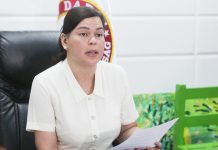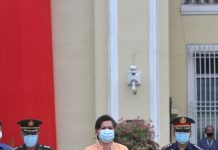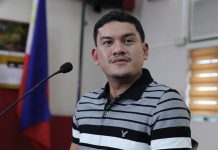– Study proponent sits in board of anti-pesticides network
– Unscientific ways in conduct of study revealed
THE Davao City-based Pilipino Banana Growers and Exporters Association has accused Department of Health-commissioned researchers of rigging a 2006 health assessment on residents of Camocaan, Hagonoy, Davao del Sur where a banana plantation was operating. The accusation came after PBGEA reportedly found out, among other things, that one of the study proponents is a member of the board of directors of the Pesticide Action Network Philippines (PAN-Philippines). PAN-Philippines is reportedly part of an international network dedicated to the total eradication of the use of chemicals in agricultural farms.
In a press statement, PBGEA spokesman Anthony Sasin,said the study was “rigged to give credence to the claims of Dr. Romeo Quijano that said sitio was poisoned due to the aerial spraying of low-dose fungicide.”
Sasin said the PBGEA found out that Dr. Lynn Crisanta R. Panganiban sits in the board of directors of the PAN-Philippines, an organization headed by Quijano.
He concluded that based on the investigationzraw risk that they tried to establish against aerial spraying is purely anecdotal and non-existent.”
Rivera was among those who conducted the study.
In the 2006 study made public last June, the proponents claimed that the study was undertaken as a result of the Quijano report. But in a public forum in Camocaan last June, Dionisio, lead investigator of the study, denied that the study was prompted by the report of Quijano.
Quijano mentioned that some of the residents died of aerial spraying, while many suffered various diseases to the practice of the aerial spraying.
But during an investigation conducted by the PBGEA and CropLife, an agro-chemical group, it as found that those whom Quijano repeatedly reported to have died or sick with various diseases used in aerial spraying, showed up and belied his claims.
Sasin said his group has already provided the Inter-Agency Committee on Environmental Health (IACEH) a copy of the findings of the technical committee as well as statements from witnesses that were stored in videotapes.
Among these witnesses was Adela Amado, a barangay health worker, who claimed that Rivera left her and the others in gathering samples.
Rivera, also in the forum in Camocaan, said she gathered water sample from a fishpond and from an irrigation canal, the press statement said.
Amado even pinpointed where the water sample was taken: a mangrove pond several meters away from the village where the water from the newly-developed fishponds accumulate. This belied claims of the researchers on page 21 of the study that water samples were taken from drinking water.
Amado also claimed that she took some samples from a pile of sweepings, not from undisturbed soil. Experts of the banana association claimed this way of handling the study was “unscientific.”
“Engr. Rivera just sat in the shade while we were gathering these samples,” Amado said in the statement.
The experts of the banana group also questioned the use of high performance liquid chromatography to analyze air samples, with four of six samples negative for pesticide residue, one with an allowable level and one with residues slightly above acceptable level.
These samples should have been confirmed by mass spectrometry since the samples were not actually sprayed with fungicides. A fungicide was also analyzed by a non-selective detector (electron capture) so this should have been confirmed also,” they said.
In Baliwaga in Sta. Cruz, the control area of the study, another barangay health worker, Nara Ventura, claimed that the soil sample was taken from a mud ally in Purok Dagsa, a fact not mentioned in the study.
Ventura , who has been a barangay health worker in the area since 1986, was also quoted as saying that proponents of the study never mentioned to residents that they were subjects of a study as they were hauled so they could join a free clinic with free food.
She added that those who were subjects of the study got their laundry water from a fishpond, although this was not cited in the study. Sasin said the study even went on making a sweeping statement that “the residents have dermatologic ailments probably due to pesticides used in a nearby mango plantation.”
The mango plantation was about two kilometers away from Baliwaga.
Even the municipal health officers of Hagonoy and Sta. Cruz, Patricio Hernane and Lorraine Ana Lindong, respectively, said they have not received the names of those who were found to have been ill when the study was conducted three years ago.
“It has been three years and several months since they made the study. How long will we wait?” asked Rowelito Tigao, one of the residents of Camocaan.
Tigao, a banana plantation worker, said he and his daughter where among those who underwent medical checkup when Dionisio’s group went to the area.
The press statement quoted a local health official as saying that she and her groups “now understand why Dionisio and company hid the study for three years, did not open it for peer review, allowed it to be used as a prop in a television show, held a very low-profile public discussion on said study mostly with militants and resist contrary findings, an attitude that is un-scientific.”
She added that Dionisio even urged her to watch the television program that would discuss the pesticide issue so she would know how to answer questions on the issue. [With PR]






